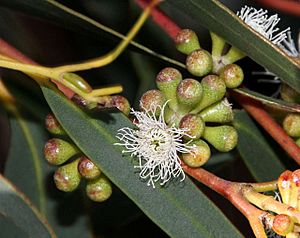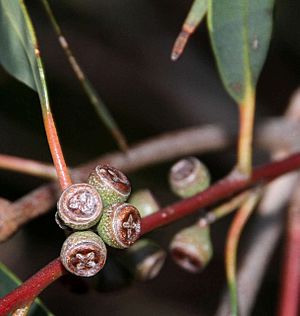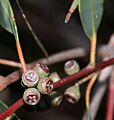Shining peppermint facts for kids
Eucalyptus willisii, also known as shining peppermint or promontory peppermint, is a type of small to medium-sized tree. Sometimes, it grows as a mallee, which is a bush with many stems growing from a large, woody base underground. This tree is found only in Victoria, Australia. It has rough, stringy bark on its trunk and branches. Its adult leaves are shaped like a spear or are slightly curved. The tree produces white flowers from buds that grow in groups of eleven to twenty-five. After flowering, it forms fruit that looks like a cup or half-sphere.
Quick facts for kids Shining peppermint |
|
|---|---|
 |
|
| Flower buds of E. willisii in Wilsons Promontory N.P. | |
| Scientific classification | |
| Genus: |
Eucalyptus
|
| Species: |
willisii
|
Contents
What the Shining Peppermint Looks Like
The shining peppermint tree, or mallee, usually grows up to 10 meters (about 33 feet) tall. It has a special woody swelling at its base called a lignotuber, which helps it regrow after fires. The bark on its trunk and bigger branches is rough and fibrous, meaning it looks like it's made of many threads.
Leaves and Flowers
Young plants and new shoots have slightly shiny leaves that are shaped like a spear or are curved. These leaves are about 64 to 85 millimeters (2.5 to 3.3 inches) long and 18 to 29 millimeters (0.7 to 1.1 inches) wide. They grow directly from the stem without a stalk and are arranged in opposite pairs.
Adult leaves are arranged alternately along the stem. They are a dull to slightly shiny blue-green on both sides. These leaves are longer, from 60 to 170 millimeters (2.4 to 6.7 inches) long and 7 to 23 millimeters (0.3 to 0.9 inches) wide. They narrow down to a leaf stalk, called a petiole, which is 6 to 18 millimeters (0.2 to 0.7 inches) long.
The flower buds grow in the leaf axils, which are the angles where a leaf joins the stem. They appear in groups of eleven to twenty-five on a short stalk called a peduncle, which is 2 to 8 millimeters (0.08 to 0.3 inches) long. Each individual bud sits on an even shorter stalk, called a pedicel, about 2 to 4 millimeters (0.08 to 0.16 inches) long.
Mature buds are oval to club-shaped, about 3 to 5 millimeters (0.12 to 0.2 inches) long and 3 millimeters (0.12 inches) wide. They have a cap-like cover called an operculum that is shaped like a half-sphere.
Flowering and Fruit
The shining peppermint flowers from September to January. Its flowers are white. After flowering, the tree produces woody, cup-shaped fruits, which are also called capsules. These fruits are 4 to 6 millimeters (0.16 to 0.24 inches) long and wide, and they sit on a pedicel 1 to 4 millimeters (0.04 to 0.16 inches) long. Each fruit has three or four valves, or sections, that open near the rim to release the seeds. The seeds are smooth, shiny, and brown to dark brown. They are pyramid-shaped but can be a bit twisted on one side.
Where the Shining Peppermint Lives
The shining peppermint is found only in Victoria, Australia. It grows from the town of Cranbourne in the west to around Bairnsdale and south to Wilsons Promontory. You can find it growing in sandy areas or on granite hills, often as part of scrubland communities.
How the Shining Peppermint Got Its Name
The Eucalyptus willisii was officially described in 1983. This happened when three scientists, Pauline Ladiges, Chris Humphries, and Ian Brooker, wrote about it in the Australian Journal of Botany. They had collected samples of the tree near Mount Oberon in Wilsons Promontory National Park in 1982. The specific name willisii was chosen to honor James Hamlyn Willis (1910 – 1995), a well-known botanist.
Images for kids




